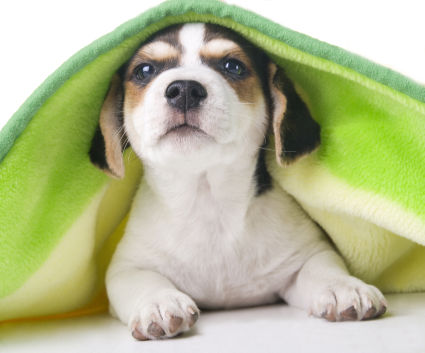Your puppy is really excelling at a game of fetch and you couldn’t be happier. But wait. Something doesn’t look right. Why is one eye partially covered?
There is no need to panic. It is your puppy’s third eyelid and the condition is really not all that uncommon.
Let’s look at the basics of a puppy’s third eyelid, which is also referred to as a nictitating membrane or haw. In essence, it a transparent or translucent eyelid that serves to moisten the eye while allowing the puppy to still see. Some say the third eyelid is often used for protection of the eye.
Unlike the puppy’s lower and upper eyelids, the haw moves horizontally across the eyeball. It is generally not able to be seen because there are no muscle fibers. In a healthy puppy eye, the nictitating membrane is usually only visible if you gently open the eye while the dog is sleeping.
When a puppy’s third eyelid is visible, it can be an indication that there is a problem such as cherry eye. The visible presence of the third eyelid can be an indication that the eyeball has sunk into its socket or that the eyeball has been pulled back into its socket.
You should be concerned if the haw suddenly becomes visible. Keep in mind that some puppies are born with haws that can be seen. This is not a condition to be concerned with. The third eyelids should not become a health hazard.
Cherry eye is a result of the weakening of the fibrous attachments to the undersurface of the haw. It is a prolapse of the tear gland that is found around the cartilage of the third eyelid. The weakening allows the gland to bulge from beneath the eyelid. As a result, the tear gland is exposed and it looks somewhat like a cherry-like growth. Irritation of the eye can result from this and cause reoccurring conjunctivitis.
Some puppy breeds are more susceptible to cherry eye. Beagles, Boston terriers, bulldogs and cocker spaniels are more likely to experience cherry eye.
The treatment for the condition is removal of the third eyelid or the tear gland. However, this can have a negative effect on your puppy because the removal of the tear gland interferes with the production of tears that moisten the eye. A dog that has the tear gland removed may require daily treatment with artificial tears for the remainder of its life.
Should you notice that your puppy’s haw suddenly becomes available, take time to make a thorough assessment of your dog’s health. Is the eye the only problem or are things amiss? If the problem is only the emergence of the haw, you may want to call the puppy’s veterinarian for advice. If other health issues show up at about the same time, it is best to err on the side of caution and make an immediate appointment with the vet.






0 Komentar